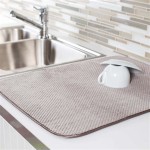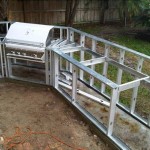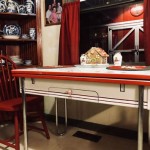4-Hole Kitchen Faucets for a Modern Bathroom Sink in Singapore
The modern bathroom design landscape in Singapore increasingly favors a blend of functionality and aesthetics. Consequently, homeowners are exploring diverse fixture options that go beyond traditional layouts. Utilizing a 4-hole kitchen faucet with a bathroom sink represents one such trend, offering potential advantages in design flexibility and operational convenience. This article will examine the factors driving this trend, the specific considerations necessary for successful implementation, and the potential benefits and drawbacks of integrating a 4-hole kitchen faucet into a contemporary Singaporean bathroom.
Traditionally, bathroom sinks were paired with faucet sets designed specifically for bathroom use, typically featuring one, two, or three holes. However, the growing desire for customized spaces has led to the cross-utilization of fixtures designed for different areas of the home. Many kitchen faucets offer a robust build quality and a wide variety of aesthetic styles, making them appealing for bathroom applications. A 4-hole configuration, common in kitchen faucets, allows for separate hot and cold water handles, a spout, and often a sprayer or other accessory. When adapted for a bathroom environment, this layout can enhance the visual appeal and functional utility of the sink area.
In Singapore, where space optimization is often a priority, the configuration of a 4-hole faucet can be strategically utilized to maximize countertop space. By separating the spout and handles, a more streamlined look can be achieved, particularly with minimalist sink designs. Furthermore, the availability of various finishes, from polished chrome to matte black, enables homeowners to precisely match the faucet with the overall bathroom aesthetic.
Key Considerations for Adapting a 4-Hole Kitchen Faucet
Adapting a 4-hole kitchen faucet for use with a bathroom sink requires several key considerations to ensure a functional and aesthetically pleasing result. Neglecting these factors can lead to installation challenges and operational inefficiencies.
1. Sink Compatibility: The first and most crucial step is to verify the sink's compatibility with a 4-hole faucet. The sink must have four pre-drilled holes arranged to accommodate the faucet's configuration. Even if the sink has four holes, the spacing between these holes must perfectly align with the faucet's specifications. Many kitchen faucets are designed for standard kitchen sink hole spacing, which may differ from standard bathroom sink hole spacings. Careful measurement and comparison are essential. If the sink does not have the requisite holes, drilling new holes is generally not recommended, particularly with porcelain or ceramic sinks, as this can lead to cracking. In such cases, selecting a different faucet configuration or replacing the sink becomes necessary.
Furthermore, the overall size and style of the sink should complement the chosen faucet. A large, industrial-style kitchen faucet might overwhelm a small, delicate bathroom sink. Conversely, a small, understated faucet could appear disproportionate on a large, basin-style sink. Thoughtful consideration of scale and proportion is vital for a cohesive design.
2. Water Supply Connections: Ensuring proper water supply connections is another critical aspect. Kitchen faucets typically use standard U.S. plumbing connections, which may differ from the standard plumbing connections used in Singaporean bathrooms. Adaptor fittings may be required to ensure a secure and leak-proof connection between the faucet's supply lines and the existing plumbing system. It is advisable to consult with a qualified plumber to determine the appropriate fittings and to ensure compliance with local building codes. Furthermore, consider the water pressure in the bathroom and whether the chosen faucet is suitable for that pressure. High water pressure can damage some faucets, while low water pressure may result in inadequate flow.
3. Sprayer Functionality: Many 4-hole kitchen faucets include a sprayer or a side spray. While this feature can be useful in a kitchen setting, its functionality in a bathroom is less clear. The sprayer hose may be awkwardly long or difficult to maneuver in a bathroom environment. Consider disabling the sprayer function if it is not needed or replacing the sprayer with a soap dispenser or a blank escutcheon plate to cover the unused hole. Alternatively, some homeowners find the sprayer useful for cleaning the sink or rinsing hair. The decision depends on individual preferences and the specific layout of the bathroom.
Advantages of Using a 4-Hole Kitchen Faucet in the Bathroom
Despite the challenges involved in adapting a kitchen faucet for bathroom use, there are several advantages that can make this a worthwhile endeavor for homeowners seeking a distinctive and functional bathroom design.
1. Enhanced Design Flexibility: 4-Hole kitchen faucets offer enhanced design flexibility compared to traditional bathroom faucets. The separate handles and spout allow for a greater degree of customization in terms of placement and style. This can be particularly useful in bathrooms with unconventional layouts or where the homeowner desires a unique and personalized aesthetic. The availability of various finishes and designs allows homeowners to match the faucet with other bathroom fixtures and accessories, creating a cohesive and visually appealing space. The larger selection of styles available in kitchen faucets allows for more adventurous design choices that may not be readily available in bathroom-specific faucets.
2. Improved Water Temperature Control: The separate hot and cold water handles provide more precise water temperature control compared to single-handle faucets. This can be particularly beneficial for individuals who are sensitive to water temperature or who require precise temperature settings for various tasks. The ability to fine-tune the water temperature can also contribute to water conservation by reducing the need to constantly adjust the faucet to find the desired temperature. Some 4-hole faucets also incorporate advanced temperature control technologies, such as scald protection, which can be particularly beneficial in households with young children or elderly individuals.
3. Durable and Robust Construction: Kitchen faucets are generally built to withstand more frequent and heavy use than bathroom faucets. This is because kitchens typically experience higher levels of activity and water usage compared to bathrooms. As a result, kitchen faucets often feature more durable and robust construction, using high-quality materials such as solid brass or stainless steel. By using a kitchen faucet in the bathroom, homeowners can benefit from this enhanced durability and expect a longer lifespan for the fixture. In a high-use bathroom, where the faucet is constantly being turned on and off, the robust construction of a kitchen faucet can be a significant advantage.
Potential Drawbacks and Challenges
While leveraging a 4-hole kitchen faucet for a bathroom sink presents enticing possibilities, several potential drawbacks and challenges need careful consideration before proceeding with such an installation.
1. Installation Complexity: As previously mentioned, the installation process can be more complex compared to installing a standard bathroom faucet. The requirement for adaptor fittings, potential modifications to the plumbing system, and the need to address the sprayer function can add time and expense to the project. It is highly recommended to engage a qualified plumber to ensure proper installation and compliance with local building codes. Incorrect installation can lead to leaks, water damage, and voiding of the faucet's warranty. Furthermore, the plumber needs to be familiar with both kitchen and bathroom plumbing standards to ensure a seamless integration.
2. Aesthetic Compatibility: Despite the design flexibility offered by 4-hole faucets, ensuring aesthetic compatibility with the overall bathroom design can be challenging. Kitchen faucets tend to have a more utilitarian or industrial aesthetic, which may not be suitable for all bathroom styles. Careful selection is crucial to ensure that the faucet complements the sink, countertop, and other bathroom fixtures. Consider the finish, shape, and size of the faucet in relation to the other elements of the bathroom. A mismatch in style can detract from the overall aesthetic appeal of the space. It may be beneficial to review design magazines or online resources for inspiration and to visualize how the chosen faucet will look in the bathroom.
3. Potential for Overwhelmed Sink: Kitchen faucets are often larger and more imposing than bathroom faucets. This can overwhelm a smaller bathroom sink, creating a visual imbalance and potentially hindering functionality. The spout may be too long, causing water to splash outside the sink, or the handles may be too large and difficult to operate comfortably. It is crucial to select a faucet that is appropriately sized for the sink and the overall bathroom space. Consider the dimensions of the faucet and the sink, and ensure that there is adequate clearance for comfortable use. Visiting a showroom and physically examining the faucet is highly recommended before making a purchase.
In conclusion, the integration of a 4-hole kitchen faucet into a modern bathroom sink in Singapore provides a path towards customized aesthetics and enhanced functionality, but necessitates careful planning and execution. The compatibility of the sink, the adaptation of water supply connections, and the mitigation of potential aesthetic mismatches are all critical factors that must be addressed to achieve a successful outcome. The potential advantages, including enhanced design flexibility, water temperature control, and durable construction, must be weighed against the potential drawbacks, such as installation complexity and the risk of overpowering the sink's design. By carefully considering these factors, homeowners can determine whether adapting a 4-hole kitchen faucet is the right choice for their modern bathroom.

Matte Black Kitchen Faucet 2 Handle 4 Hole Sink Mixer With Side Sprayer

Waterstone Faucets 5130 4 Sg Endeavor Wheel Pull Down Faucet Lever Sprayer Piece Suite Satin Gold

Grandjoy 4 In Waterfall Centerset Double Handle High Arc Bathroom Faucet 1 0 Gpm Matte Black Valve Included Sgf11gj 16 Bl The Home Depot

Open Trough Waterfall 4 In Centerset Double Handle Bathroom Faucet 1 03 Gpm Matte Black Drain Not Included

Waterstone Faucets 10360 4 Amb Fulton 16 1 8 Inch Modern Lever Sprayer Plp Pulldown Faucet With Soap Dispenser Air Switch And Single Port Gap

Kitchen Sink Faucet With Pull Out Side Sprayer 2 Handle High Arc 4 Hole Nickel

Grandjoy 4 In Waterfall Centerset Double Handle High Arc Bathroom Faucet 1 0 Gpm Matte Black Valve Included Sgf11gj 16 Bl The Home Depot

Margaux Single Hole Bathroom Sink Faucet With 5 3 8 Spout And Lever Handle 16230t 4 Kohler

Modern Black Kitchen Sink Faucet Pull Out Sprayer Single Handle 1 Hole Mixer Tap

4 In Centerset Double Handle Bathroom Sink Faucet With Pop Up Drain Brushed Gold Sg4
Related Posts








